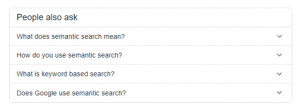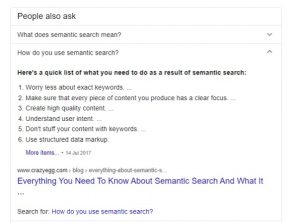There was a time where pretty much all you needed to do to get your website ranking was to include relevant key terms in your content and search engines would use that information to display results to users. I know, because I was there the very month Google launched, helping clients reach their ideal audience with SEO.
But we’ve come a long way since those relatively simple days. SEO has expanded greatly in that time. We don’t just have users searching for content to be displayed on their desktops and mobile devices, we have voice search and the Internet of Things transforming the ways we interact with search engines.
And we have users who increasingly want more comprehensive results than simply a description of the topic they have searched for.
These changes in SEO have resulted in the concept of semantic search, which is about providing highly contextual content to user queries, and answer engine optimisation, in which users are presented with a single, comprehensive answer to their question. Let’s look at each of these concepts in turn.
What is Semantic search?
Standard SEO is about using key words and phrases that users are searching for in a bid to get search engines to serve this content up to users.
But search engines like Google aren’t merely interested in serving up ‘relevant’ content to users. They want to provide users the best, most comprehensive content. Content that anticipates the reason why searchers are querying a topic in the first place and anticipates the follow-up questions they might have.
Semantic SEO helps you get more traffic to your website by using specifically targeted metadata and search terms that anticipate the needs of searchers.
To apply semantic SEO, here are some of the questions we need to answer:
- What problems are your audience trying to solve?
- How can your content solve these problems?
- After solving this initial problem, what follow up queries can your content address?
Let’s take this article as an example of using semantic search.
Let’s say we want this article to rank for the key term “semantic search”.
Ok, so that’s the keyword. But what is the context in which users are going to be searching for this term?
Here are some of the main reasons people are going to be searching for this term…
- They’ve heard of semantic search, but are not really sure what it is.
- They know what semantic search is but aren’t sure how they can use it.
- They know semantic search is useful but need someone to help them implement it.
The reality is that all three of the above queries are likely to be running through the search user’s mind. They likely wouldn’t be Googling the term if they knew exactly what it is, but if they’re searching for it it’s probable because they think it might be able to help them. If they think it can help them they’ll probably want to know how to put it into practice, and so on.
So now we have our SEO term, and we also understand something about the deeper meaning behind why users are searching for it.
Fortunately, we can also use Google to help get a better understanding of what users are searching for.
Related search and semantic search
At the bottom of the Google results page is a section listing related searches.

If you look at the searches listed in the image above you can see that not all are going to be relevant to our purposes, but we can see that users want to know how semantic search is different to keyword research, how it can be used in e-commerce, and what the benefits of semantic search are.
As you can see, we need a deep understanding of what words search users are using, and the context in which they are using them. This helps us anticipate their needs and create content that answers those needs.
When it comes to semantic search, structure is very important.
We want to make sure we have phrases that users are likely searching for and we send signals to search engines that our content answers these queries.
We can do this by integrating the semantic keywords we’ve discovered into the headings and subheadings of our content, including them in the meta data and meta tags we use.
Using the ‘people also ask’ field
Another place where google is showing us the user intent behind search queries is in the ‘people also ask section’ on the Google results page.

You can click on the dropdown field next to each user query and Google will show you how other blog posts have answered these queries.

This will help you understand not only what users are searching for, but how other web pages are effectively answering those queries. This is a fantastic insight into the kind of content you need to create.
Semantic search and structured data markup
As you carry out this kind of research you can steadily build up a ‘query profile’ of exactly what users are searching for content.
So choosing words that relate to the meaning of search terms is really important. But there are also technical aspects to SEO that go beyond the words you write on the page. Search engines use a shared library of HTML-style markup called schema markup. This is used to send signals to search engines that certain parts of your page are really important.
By marking content with schema it increases the chance that it will be displayed to users in the various ‘snippets’ that feature on search engines like Google. Here’s an example of a snippet on Google that features in the ‘also ask’:

Here we can see that Google has pulled out the content from a post that answers the question ‘how to create rich snippets’ using a list of answers.
The reason this web content is appearing in this section of Google is because users are getting value from it, which is why its ranking so well.
By analysing the content that is performing well we can get a deeper understanding of what users want, and address those topics in our content. This is the essence of semantic search.
What is Answer Engine Optimisation?
Answer engine optimisation, or AEO, is the technique of creating content that is suited for voice search queries, which have been growing in prevalence with the rise of digital assistants like Siri and Alexa.
What is an answer engine?
The rise of voice search via mobile devices is transforming search engines like Google into so-called ‘answer engines’ that provide definitive answers to user queries, rather than showing them a page of potential sites to choose from.
When a user asks a direct question to Alexa, they are typically not even looking at a screen. Perhaps they are cooking and ask “how long does it take to boil an egg?” (it happens).
Here’s an example from Google assistant:

Google has found the best answer to the question ‘how long does it take to boil an egg?’ and has presented a relevant snippet of text to the user which is also presented via a text reader.
Answer engine optimisation goes far beyond the concept of search engines crawling for specific phrases and serving relevant content up to users. For example if we look at the egg boiling query above we have to ask ‘how did Google know which bit of the article to read out to the user?
If we go to the page Google is reading from we can see the section of text the answer has been taken from:

If we were to look at the HTML behind this page we will see that it is structured to be easily read by search engines, thus increasing the chance it will be served up by an answer engine.
AEO, HTML5, and schema markup
The more specific information you can communicate to search engines the more likely your content will be served up by an ‘answer engine’.
There are technical techniques that can be used to do this like using HTML5 and schema markup to help search crawlers understand where to find relevant answers to questions.

In the egg example above the website in question has used html to mark up which sections of the page do what. For example, there’s a section for a video, a section that describes the equipment that you need, and another section that has been tagged “description-para” in the site’s code.
All these technical elements help Google understand what your content is all about, and present it to users accordingly.
AEO is a strategy, not a tactic
Answer engine optimisation needs to be understood as a strategy. It’s important that search engines know they’re providing the best answer to users, because they can only provide one answer rather than a page full of results for the user to choose from. Because of this to master AEO you need to be able to communicate your brand’s credibility to search engines. This involves taking an ‘holistic’ approach to optimising your content.
For example, you can use ‘schema markup’ to signal that your brand has expertise in your field. So the next time Google needs to search for the best info to answer a specific question your content is in the running for getting served as an answer.
For example, you can use schema to signal that a piece of content is a recipe and flag up relevant info such as cooking time, ingredients, and so on. This will help search algorithms when trying to display recipes to a user asking ‘how to boil an egg’, to take the example we used above.

Will AEO replace SEO?
AEO won’t replace SEO entirely, but it will affect how it evolves. In fact what we’re starting to see is a mix of AEO and SEO in results pages. Amazon’s Echo Show will offer users a selection of choices when querying a recipe, for example, which is like a stripped back version of standard search results pages.

As AEO (and SEO) gets more sophisticated there will be more and more opportunities for brands to get their content in front of the right people.
To do this it’s important to have a content strategy in place that is appropriate for your brand’s position in the market, and that makes the most out of your digital content.
Socially Grown can help you implement semantic search and answer engine optimisation into your current SEO strategy. Get in touch to book a free consultation today.

